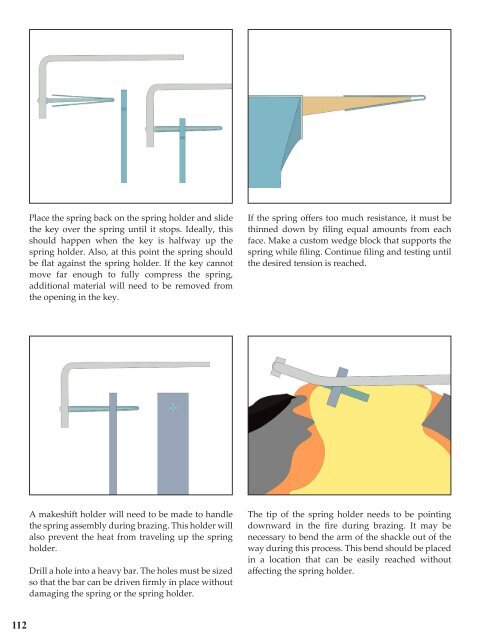The New Spruce Forge Manual of Locksmithing: A Blacksmith’s Guide to Simple Lock Mechanisms
The New Spruce Forge Manual of Locksmithing: a Blacksmith’s Guide to Simple Lock Mechanisms is a totally revised and expanded version of the original work from 1999. This new hardcover edition, at 304 pages and with more than 800 color photos and illustrations, is more than double the size of the original manual. It is divided into two distinct sections: Technical Information - This section is a reference manual in itself that covers the specific tools and techniques needed to build all the parts for each lock, as well as providing the information needed to understand the assembly instructions outlined in the second section. The Locks: Patterns & Instructions - This section provides the plans and detailed instructions for each of the 14 lock projects in this new edition. The clear assembly instructions describe when and how to use the technical information provided in section one. The authors have maintained their original trademark style that relies on well-illustrated step-by-step instructions that guide you through the whole lock-making process. They have also kept their low-tech approach that demonstrates how to go about creating good work using only a handful of simple tools. Making blacksmith locks is an age-old skill the authors of this manual are helping to preserve by passing on their knowledge to this book’s readers. The New Spruce Forge Manual of Locksmithing is also an excellent introduction to benchwork, which is a useful skill for any blacksmith to acquire. This manual will become a valuable, trusted and often referred to sourcebook in your blacksmithing library. Hardcover, 304 pages, more than 800 photos and illustrations.
The New Spruce Forge Manual of Locksmithing: a Blacksmith’s Guide to Simple Lock Mechanisms is a totally revised and expanded version of the original work from 1999. This new hardcover edition, at 304 pages and with more than 800 color photos and illustrations, is more than double the size of the original manual.
It is divided into two distinct sections:
Technical Information - This section is a reference manual in itself that covers the specific tools and techniques needed to build all the parts for each lock, as well as providing the information needed to understand the assembly instructions outlined in the second section.
The Locks: Patterns & Instructions - This section provides the plans and detailed instructions for each of the 14 lock projects in this new edition. The clear assembly instructions describe when and how to use the technical information provided in section one.
The authors have maintained their original trademark style that relies on well-illustrated step-by-step instructions that guide you through the whole lock-making process. They have also kept their low-tech approach that demonstrates how to go about creating good work using only a handful of simple tools.
Making blacksmith locks is an age-old skill the authors of this manual are helping to preserve by passing on their knowledge to this book’s readers. The New Spruce Forge Manual of Locksmithing is also an excellent introduction to benchwork, which is a useful skill for any blacksmith to acquire. This manual will become a valuable, trusted and often referred to sourcebook in your blacksmithing library.
Hardcover, 304 pages, more than 800 photos and illustrations.
You also want an ePaper? Increase the reach of your titles
YUMPU automatically turns print PDFs into web optimized ePapers that Google loves.
Place the spring back on the spring holder and slide<br />
the key over the spring until it s<strong>to</strong>ps. Ideally, this<br />
should happen when the key is halfway up the<br />
spring holder. Also, at this point the spring should<br />
be flat against the spring holder. If the key cannot<br />
move far enough <strong>to</strong> fully compress the spring,<br />
additional material will need <strong>to</strong> be removed from<br />
the opening in the key.<br />
If the spring <strong>of</strong>fers <strong>to</strong>o much resistance, it must be<br />
thinned down by filing equal amounts from each<br />
face. Make a cus<strong>to</strong>m wedge block that supports the<br />
spring while filing. Continue filing and testing until<br />
the desired tension is reached.<br />
A makeshift holder will need <strong>to</strong> be made <strong>to</strong> handle<br />
the spring assembly during brazing. This holder will<br />
also prevent the heat from traveling up the spring<br />
holder.<br />
Drill a hole in<strong>to</strong> a heavy bar. <strong>The</strong> holes must be sized<br />
so that the bar can be driven firmly in place without<br />
damaging the spring or the spring holder.<br />
<strong>The</strong> tip <strong>of</strong> the spring holder needs <strong>to</strong> be pointing<br />
downward in the fire during brazing. It may be<br />
necessary <strong>to</strong> bend the arm <strong>of</strong> the shackle out <strong>of</strong> the<br />
way during this process. This bend should be placed<br />
in a location that can be easily reached without<br />
affecting the spring holder.<br />
112










